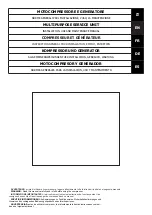
Istruzioni per l’uso e manutenzione
Cod. OQ7.5ARG114 – GB
Emiss. 19-01-11 Rev. 0 - Agg. /
41
POWER SYSTEM SRL
Via dell’Emigrante, 11/13 - 36040 Brendola (VI) Italia
22
OPERATING PRINCIPLE
•
When the motor has reached steady operating speed
: in this phase the air passes through the intake valve (2) and arrives at the
compressor (3).
•
In this phase the compressor operates at full speed, compressing the air inside the separator tank (4).
•
The compressed air
does not come out of the minimum valve (6) until a pressure of 3÷4 bar has been reached (minimum valve
calibration pressure).
•
The compressed air
compresses the oil inside the separator tank and forces it to flow through the pipes towards the thermostatic
valve (9) and towards the oil radiator (10).
•
If the oil temperature is lower than 71°C
, the oil coming from the pipe flows directly to the compressor through the thermostatic
valve (9) passing through the filter (11).
•
If the oil temperature is higher than 71°C
the thermostatic valve (9) closes the pipe duct, making the oil arrive at the compressor
through the radiator (10), passing through the filter (11).
•
The oil arrives at the compressor
and mixes with the air taken in, creating an air/oil mixture which guarantees the seal and
lubrication of the moving parts of the compressor.
•
The air/oil mixture
into the separator tank (4) undergoes a centrifugal and then a final separation of the oil by means of the
separator filter.
•
Then only water comes out of the tank,
arrives at the final air cooler (7), passes through the condensate separator (8) and then
goes to the network.
•
The light oil residue
deposited at the bottom of the separator filter is sent back into the compressor through the oil recovery pipe.
•
When the maximum working pressure
set on the electronic board is reached the compressor works without load until the system
pressure reaches the reset value. If this no-load operating time is long, due to low or ceased consumption, the compressor stops in
stand-by mode.
In machines with a dryer:
•
The condensate recovered
in the condensate separator (8) is discharged automatically by the electrovalve (17) commanded by the
board.
















































